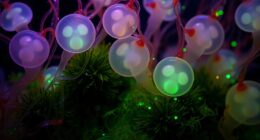Incorporating art into STEM learning creates a dynamic STEAM education that sparks your creativity and encourages innovative thinking. By blending arts with science, technology, engineering, and math, you’ll explore problems from multiple angles and develop practical, aesthetic solutions. This interdisciplinary approach enhances collaboration and helps you tackle real-world challenges with flexibility and imagination. Keep exploring to discover how integrating art can revolutionize your approach to problem-solving and learning.
Key Takeaways
- Arts integration enhances creativity and innovation in STEM projects, fostering diverse problem-solving approaches.
- Combining arts with STEM encourages interdisciplinary collaboration, enriching understanding and teamwork skills.
- Artistic elements make STEM concepts more engaging and accessible through visual and interactive displays.
- Incorporating art supports design thinking, leading to more user-centered and practical solutions.
- STEAM education prepares learners for complex challenges by developing versatile, creative, and adaptable skills.

Have you ever wondered how integrating science, technology, engineering, arts, and math can transform education? When you bring these fields together through STEAM education, you open doors to innovative ways of thinking and learning. At the heart of this approach is creative problem solving. Instead of following a step-by-step method, you’re encouraged to think outside the box, explore multiple solutions, and adapt your ideas on the fly. This process not only boosts your ability to tackle real-world challenges but also nurtures your imagination and curiosity. By blending arts with STEM disciplines, you’re invited to express your ideas visually, audibly, or through hands-on projects, making learning more engaging and meaningful.
Integrating arts into STEM sparks creativity, innovation, and engaging, real-world problem solving.
Interdisciplinary collaboration plays a vital role in STEAM education. When you work with others from diverse backgrounds, you gain new perspectives that enrich your understanding. For example, teaming up with a peer who excels in engineering while you bring artistic skills can lead to a project that’s both technically sound and creatively inspiring. This kind of collaboration encourages you to communicate your ideas clearly, listen to different viewpoints, and compromise when necessary. It mirrors real-world work environments where cross-disciplinary teams solve complex problems together. As you share your expertise and learn from others, you develop a versatile skill set that combines technical knowledge with creative insight. Incorporating asset division strategies into project planning can also teach valuable lessons about fairness and resource management. Additionally, understanding how multidisciplinary skills complement each other can help you approach challenges more effectively.
Integrating arts into STEM isn’t just about adding decoration; it’s about enhancing critical thinking and innovation. When you approach a problem from multiple angles—scientific, artistic, or engineering—you develop a more in-depth understanding. For instance, designing a sustainable city requires not only technical solutions but also aesthetic considerations and social impacts. By merging arts into STEM projects, you’re encouraged to consider the human element, making your solutions more practical and appealing. This approach fosters a mindset where creativity fuels technological advancements, and technical skills inform artistic expression. Additionally, incorporating elements like interactive exhibits or visual displays can make complex concepts more accessible and engaging for learners of all ages. Furthermore, understanding how design thinking can be applied to these projects helps you develop innovative solutions more effectively.
In essence, STEAM education transforms the way you learn and solve problems. It pushes you to look beyond traditional boundaries, collaborate across disciplines, and develop innovative solutions. By emphasizing creative problem solving and interdisciplinary collaboration, it prepares you for a future where versatility and ingenuity are key. This integrated approach helps you see connections between subjects, inspiring you to become a well-rounded thinker capable of addressing the complex challenges of tomorrow.
Frequently Asked Questions
How Does Art Enhance Problem-Solving Skills in STEM?
Art enhances problem-solving skills in STEM by fostering creative thinking and encouraging innovative solutions. When you use visual communication through drawing or modeling, you can better understand complex concepts and identify new approaches. Engaging with art allows you to think outside the box, challenge assumptions, and develop unique solutions. As a result, your ability to analyze problems and generate effective strategies improves, making you a more versatile and inventive problem solver in STEM fields.
What Are Successful Examples of STEAM Projects in Schools?
Imagine bright murals transforming classroom walls, students working together on sleek prototypes, and vibrant presentations showcasing their ideas. These successful projects highlight interdisciplinary collaboration and innovative design, blending creativity with technical skills. Schools often create robotics teams that paint and decorate their robots or develop eco-friendly models with artistic flair. Such projects foster teamwork, inspire imagination, and demonstrate how combining art and STEM sparks real-world solutions and engaging hands-on learning experiences.
How Can Teachers Integrate Art Seamlessly Into STEM Curricula?
To integrate art seamlessly into STEM curricula, you can foster creative collaboration among students by designing projects that combine artistic expression with scientific concepts. Encourage students to visualize data through art, build models that reflect scientific principles, or create multimedia presentations. These activities make learning engaging, help students see connections, and develop skills in both STEM and artistic disciplines, enriching their overall educational experience.
What Are the Benefits of STEAM Education for Student Creativity?
You’ll notice that STEAM education boosts student creativity by fostering interdisciplinary collaboration, allowing students to connect ideas across subjects. This approach helps build creative confidence, encouraging them to experiment and think outside the box. As you integrate art into STEM, students develop a broader perspective, enhancing their problem-solving skills and inspiring innovative solutions. Ultimately, this method nurtures a more dynamic, imaginative learning environment where creativity thrives.
How Does STEAM Prepare Students for Future Careers?
You’re preparing for future careers by fostering interdisciplinary collaboration and encouraging innovative thinking. These skills help you adapt to rapidly changing industries, solve complex problems, and work effectively with diverse teams. By integrating creativity with technical knowledge, you develop a versatile mindset. This approach equips you to navigate new challenges, embrace emerging opportunities, and stay ahead in a competitive job market, ultimately setting you up for long-term success.
Conclusion
As you embrace STEAM education, remember it’s like blending colors on a canvas—each element enriching the whole. Incorporating art into STEM transforms learning into a vibrant masterpiece, sparking creativity and innovation. By connecting these worlds, you open new ways to inspire curiosity and problem-solving. So, jump in and let your teaching be the brushstroke that turns science and technology into a beautiful, engaging adventure—where imagination truly knows no bounds.









